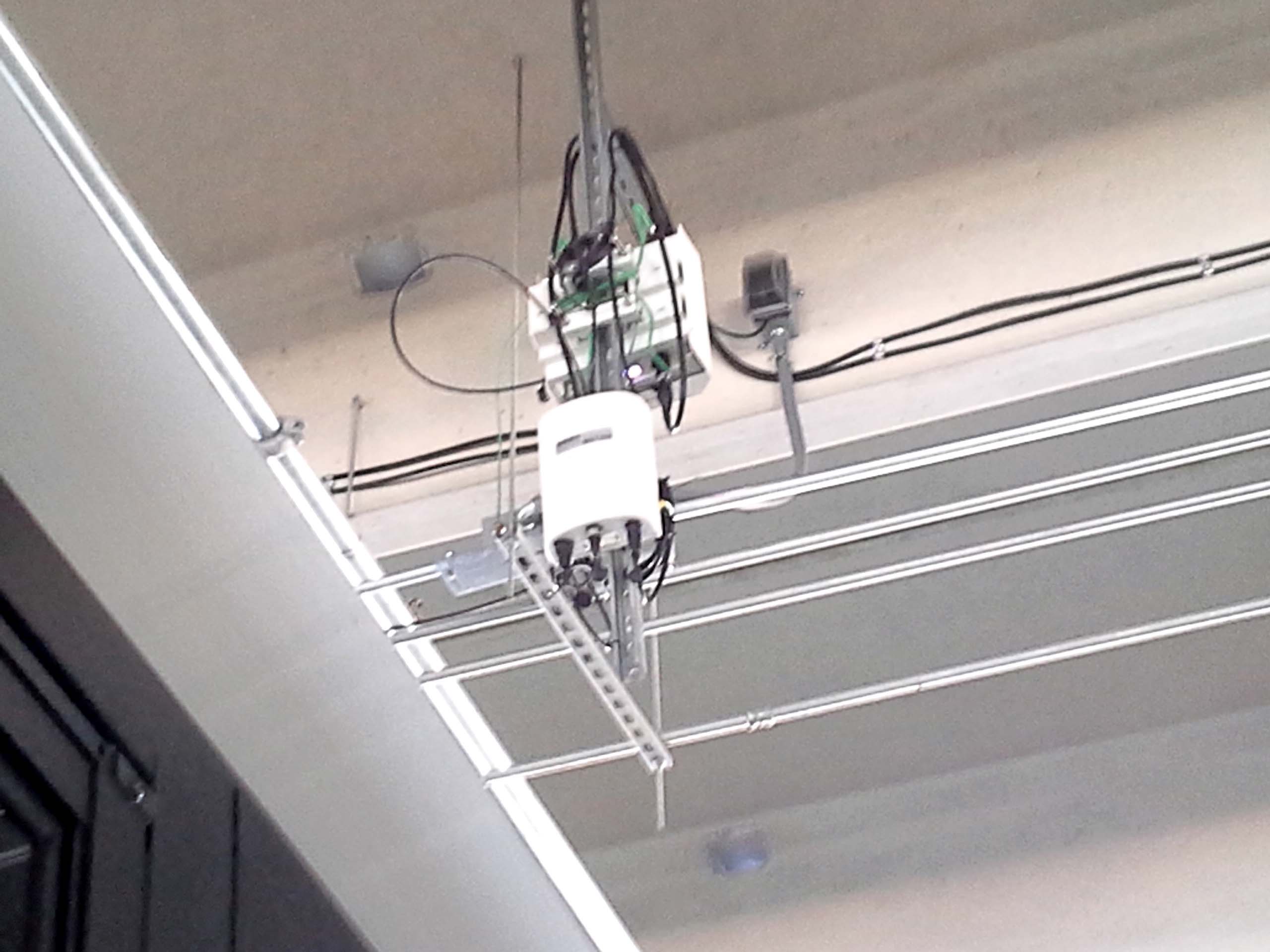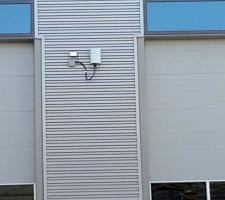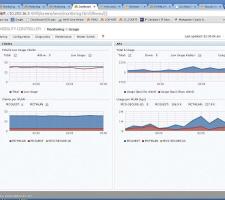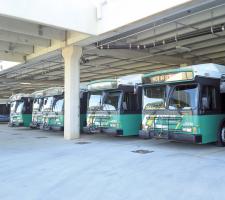
Ceiling-mounted WAPs played a key role in ensuring coverage
Ted Bowser explains how the almost total Wi-Fi coverage at Ride-On’s new bus garage is providing big benefits for the operator and passengers alike.
The ability to download and upload data to and from the various systems on board buses has become central to mass transit operators’ business model. So when Ride-On, the public transportation system in Maryland’s Montgomery County, was moving one of its three depots into a bigger and purpose-built facility, connectivity was a key consideration.
System capability needed to be very high as Ride-On uses a real-time computer aided dispatch/automatic vehicle locator (CAD/AVL) system and streams video to record activity on the bus in case there is a disturbance or criminal activity. This is in addition to ridership data, information on cash and other transactions, route allocation and timing/punctuality figures.
There is also a GPS system onboard sending location information back to the CAD/AVL, allowing central operations to track the fleet of 350 buses and supervisory vehicles, update real-time traveller information and reroute buses to avoid congestion.
Ride-On has three depots across the 1,300km2 (500 squ mi) county and its Gaithersburg operation was moving to a new equipment maintenance and transit operations centre housing 200 buses plus space for future fleet expansions. The existing facility used wireless data transfer facility which only worked when the bus was in the open parking lot and in line of sight of an antenna (the same was true for the technicians’ laptops). Once the bus was inside the work bays, the wireless devices were useless.
The county’s buses operate 22hrs/day and during the downtime each bus is inspected, refuelled, cleaned and washed and (if needed) the advertising is changed inside and out. While this is happening each bus has to login to the network, upload the day’s passenger and fare box data to the centralised databases and download route information for the following day.
For these reasons, physical connection to each bus was impractical so the challenge was to create a wireless transfer system inside the planned two-storey 21,600m2 (323,981ft2) concrete and steel structure. Not only was the structure itself an impediment to data transfer, the building would be filled with up to 200 aluminium and steel buses each 13.7m (45ft) long and 3.4m (11.3ft) tall - adding further obstructions to wireless communication.
Three options were considered: a third-party turnkey solution, linking a laptop or CAT5e cable to each bus to perform the tasks manually, or implementing a wireless data transfer network.
Daily time constraints had ruled out the laptop/cable option while a turnkey solution was prohibitively expensive and could not be implemented before the move, leaving only the bespoke wireless option. However, pan-facility Wi-Fi coverage would be tricky as the data needed to be transferred without interruption while the buses move around the depot. If transmission is interrupted, the time taken to reconnect and authenticate before the process can continue or start over would create untenable delays.
Beyond developing a system in the garage, additional links would be required to the County’s centralised servers as the fare box data from each Ride-On bus is sent to the Transportation Authority’s facility in Washington DC. This was a particular concern for John Castner, the manager of network services for Montgomery County Government.
The biggest technical problem was getting floor to ceiling wireless coverage across the ground level of the bus-filled concrete and steel garage (the upper deck is used for staff parking) to transfer data via the buses’ roof-mounted antenna.
Ride-On’s Network Services Team took on the challenge and senior IT specialists Greg Vernoy, David Chen and Doug Grover were tasked with developing and implementing a wireless data transfer system. Having worked with the Aruba wireless equipment for more than 18 months, Vernoy took on the majority of the design and development work. Having studied the building plans and the signal footprints of various types of hardware, Vernoy decided on a wireless mesh network. To overcome structural limitations, the system included multiple signal configurations which should allow seamless transmission transfer from one wireless access point (WAP) to another as the buses move around the garage.
Vernoy’s proposed solution used umbrella-overlapping signals from extended-antenna ceiling-mounted WAPs with additional elliptical signals from pole-mounted WAPs and directional (line of sight) signals from wall-mounted devices. “The proposed system would create small radio frequency cells throughout the campus both inside the structure and around the exterior,” he said.
If everything worked properly, it would not only allow seamless data transfer from moving vehicles in the garage but also enable the fleet management staff to wirelessly link to the fleet management software as the technicians serviced the buses. Engineers from equipment supplier Aruba thought the design could work but had not implemented anything similar, so a proof of concept test was undertaken in a small area used to house highway maintenance vehicles. As the test proved successful providing upload and download speeds to the maximum 750kps available from the on-board devices, Vernoy set about configuring a system to span the entire parking garage and maintenance bays.
Once on site, he tried several WAP placement configurations, signal strength and coverage areas. “The only thing that would seem to work would be to flatten the wireless signal so that the Wi-Fi coverage elongated, creating an umbrella with overlapping signals that would pass between the buses to the floor,” he said.
Full signal coverage was indeed accomplished by creating a plan of WAP placements and coverage areas and once the Aruba Wi-Fi devices were deployed, the Network Services Team adjusted the placements to maximise the signal footprints within the empty building. The next step was to cover the floor area with buses to replicate the obstruction the Wi-Fi signal will encounter in a busy bus garage and make the necessary adjustments to allow wireless connectivity to the network from anywhere in the garage.
The finalised network uses 32 ceiling mounted and 22 pole/wall mounted WAPs on the main level which combine to provide coverage across almost 17,900m2 (192,440ft2) of useable floor area.
The system had to work before the move could happen so program specialist Andy Mangene and IT specialist Jin Gu (Ride-On’s technical implementation team) devised a test plan. Gu, who is aiming to add video streaming as part of the upload process while the bus in at the depot, said: “We were concerned with security, bandwidth and connectivity.” For Mangene it was the timeframe and integrity of the data transfer process that was concerning.
To test the automatic login and authentication process, the duo took a laptop that was already logged into the County’s network in their office and drove to the depot and once in range of the Wi-Fi the laptop automatically reconnected. In testing the wireless access to Ride-On’s technical infrastructure the duo connected the laptop to the central servers and ran a major application, proving the response time was both adequate and within expected tolerances.
Finally (and most importantly) to test for constant connectivity, the pair climbed aboard a bus and started uploading data from the on-board computer while driving around the building. Mangene in the driving seat (he drove Ride-On busses for six years) while Gu monitored the wireless data flow on his laptop. The signal from the moving bus passed from WAP to WAP without interruption (although there were some dead spots near particular columns) allowing the duo to sign off the project.
Network services monitored the progress as each of more than two hundred buses pulled into Ride-On’s new facility and started communicating through the wireless infrastructure.
When asked how it went, Vernoy said: “Given the complexities of the design, setting up secured firewalls and accessing the applications went as smoothly as I could have desired.”
Software within Montgomery County Government’s fleet management system tracks each vehicle’s registration, mileage, preventive maintenance schedule, maintenance records, work performed, the parts inventory and other information.
The new Wi-Fi system allows the technicians to enter information into a laptop or use a scanner directly at the bus bay instead of going back to a workstation to enter the information as they did at the old facility.
While the Wi-Fi transfer speeds are limited to 750kps by the on-board devices, in practice the data from a typical bus is transferred in around three minutes while downloads of the following day’s route take less than two minutes.
If the bus is late leaving the garage, central operations knows to address route issues instantly, providing passengers with reliable services information.
The download/upload success rate is around 93% and will increase as the remaining buses are retrofitted with new equipment. If a bus fails to download the next day’s data there is a satellite back-up facility which transmits the buffered information when the vehicle reaches its first time point. Equally, if for some reason the upload link to the satellite is lost, the real-time data will be buffered on the bus and transferred at the depot along with the usual download.
Castner said the technology is two generations ahead of the previous system and allows for further expansion. Its seamless transfer provides a high degree of future-proofing as it can convey voice communication which is less forgiving of transmission interruptions than data which is buffered and resent when reconnected.
In the end, the project not only showed the merits of flattening the wireless signal to produce garage-wide coverage, it also proved a concept that other transit agencies may wish to consider.
Ted Bowser works in the Telecommunications Solutions Services Section of Montgomery County Government’s Enterprise Telecommunications Division.
The ability to download and upload data to and from the various systems on board buses has become central to mass transit operators’ business model. So when Ride-On, the public transportation system in Maryland’s Montgomery County, was moving one of its three depots into a bigger and purpose-built facility, connectivity was a key consideration.
System capability needed to be very high as Ride-On uses a real-time computer aided dispatch/automatic vehicle locator (CAD/AVL) system and streams video to record activity on the bus in case there is a disturbance or criminal activity. This is in addition to ridership data, information on cash and other transactions, route allocation and timing/punctuality figures.
There is also a GPS system onboard sending location information back to the CAD/AVL, allowing central operations to track the fleet of 350 buses and supervisory vehicles, update real-time traveller information and reroute buses to avoid congestion.
Ride-On has three depots across the 1,300km2 (500 squ mi) county and its Gaithersburg operation was moving to a new equipment maintenance and transit operations centre housing 200 buses plus space for future fleet expansions. The existing facility used wireless data transfer facility which only worked when the bus was in the open parking lot and in line of sight of an antenna (the same was true for the technicians’ laptops). Once the bus was inside the work bays, the wireless devices were useless.
The county’s buses operate 22hrs/day and during the downtime each bus is inspected, refuelled, cleaned and washed and (if needed) the advertising is changed inside and out. While this is happening each bus has to login to the network, upload the day’s passenger and fare box data to the centralised databases and download route information for the following day.
For these reasons, physical connection to each bus was impractical so the challenge was to create a wireless transfer system inside the planned two-storey 21,600m2 (323,981ft2) concrete and steel structure. Not only was the structure itself an impediment to data transfer, the building would be filled with up to 200 aluminium and steel buses each 13.7m (45ft) long and 3.4m (11.3ft) tall - adding further obstructions to wireless communication.
Three options were considered: a third-party turnkey solution, linking a laptop or CAT5e cable to each bus to perform the tasks manually, or implementing a wireless data transfer network.
Daily time constraints had ruled out the laptop/cable option while a turnkey solution was prohibitively expensive and could not be implemented before the move, leaving only the bespoke wireless option. However, pan-facility Wi-Fi coverage would be tricky as the data needed to be transferred without interruption while the buses move around the depot. If transmission is interrupted, the time taken to reconnect and authenticate before the process can continue or start over would create untenable delays.
Beyond developing a system in the garage, additional links would be required to the County’s centralised servers as the fare box data from each Ride-On bus is sent to the Transportation Authority’s facility in Washington DC. This was a particular concern for John Castner, the manager of network services for Montgomery County Government.
The biggest technical problem was getting floor to ceiling wireless coverage across the ground level of the bus-filled concrete and steel garage (the upper deck is used for staff parking) to transfer data via the buses’ roof-mounted antenna.
Ride-On’s Network Services Team took on the challenge and senior IT specialists Greg Vernoy, David Chen and Doug Grover were tasked with developing and implementing a wireless data transfer system. Having worked with the Aruba wireless equipment for more than 18 months, Vernoy took on the majority of the design and development work. Having studied the building plans and the signal footprints of various types of hardware, Vernoy decided on a wireless mesh network. To overcome structural limitations, the system included multiple signal configurations which should allow seamless transmission transfer from one wireless access point (WAP) to another as the buses move around the garage.
Vernoy’s proposed solution used umbrella-overlapping signals from extended-antenna ceiling-mounted WAPs with additional elliptical signals from pole-mounted WAPs and directional (line of sight) signals from wall-mounted devices. “The proposed system would create small radio frequency cells throughout the campus both inside the structure and around the exterior,” he said.
If everything worked properly, it would not only allow seamless data transfer from moving vehicles in the garage but also enable the fleet management staff to wirelessly link to the fleet management software as the technicians serviced the buses. Engineers from equipment supplier Aruba thought the design could work but had not implemented anything similar, so a proof of concept test was undertaken in a small area used to house highway maintenance vehicles. As the test proved successful providing upload and download speeds to the maximum 750kps available from the on-board devices, Vernoy set about configuring a system to span the entire parking garage and maintenance bays.
Once on site, he tried several WAP placement configurations, signal strength and coverage areas. “The only thing that would seem to work would be to flatten the wireless signal so that the Wi-Fi coverage elongated, creating an umbrella with overlapping signals that would pass between the buses to the floor,” he said.
Full signal coverage was indeed accomplished by creating a plan of WAP placements and coverage areas and once the Aruba Wi-Fi devices were deployed, the Network Services Team adjusted the placements to maximise the signal footprints within the empty building. The next step was to cover the floor area with buses to replicate the obstruction the Wi-Fi signal will encounter in a busy bus garage and make the necessary adjustments to allow wireless connectivity to the network from anywhere in the garage.
The finalised network uses 32 ceiling mounted and 22 pole/wall mounted WAPs on the main level which combine to provide coverage across almost 17,900m2 (192,440ft2) of useable floor area.
The system had to work before the move could happen so program specialist Andy Mangene and IT specialist Jin Gu (Ride-On’s technical implementation team) devised a test plan. Gu, who is aiming to add video streaming as part of the upload process while the bus in at the depot, said: “We were concerned with security, bandwidth and connectivity.” For Mangene it was the timeframe and integrity of the data transfer process that was concerning.
To test the automatic login and authentication process, the duo took a laptop that was already logged into the County’s network in their office and drove to the depot and once in range of the Wi-Fi the laptop automatically reconnected. In testing the wireless access to Ride-On’s technical infrastructure the duo connected the laptop to the central servers and ran a major application, proving the response time was both adequate and within expected tolerances.
Finally (and most importantly) to test for constant connectivity, the pair climbed aboard a bus and started uploading data from the on-board computer while driving around the building. Mangene in the driving seat (he drove Ride-On busses for six years) while Gu monitored the wireless data flow on his laptop. The signal from the moving bus passed from WAP to WAP without interruption (although there were some dead spots near particular columns) allowing the duo to sign off the project.
Network services monitored the progress as each of more than two hundred buses pulled into Ride-On’s new facility and started communicating through the wireless infrastructure.
When asked how it went, Vernoy said: “Given the complexities of the design, setting up secured firewalls and accessing the applications went as smoothly as I could have desired.”
Software within Montgomery County Government’s fleet management system tracks each vehicle’s registration, mileage, preventive maintenance schedule, maintenance records, work performed, the parts inventory and other information.
The new Wi-Fi system allows the technicians to enter information into a laptop or use a scanner directly at the bus bay instead of going back to a workstation to enter the information as they did at the old facility.
While the Wi-Fi transfer speeds are limited to 750kps by the on-board devices, in practice the data from a typical bus is transferred in around three minutes while downloads of the following day’s route take less than two minutes.
If the bus is late leaving the garage, central operations knows to address route issues instantly, providing passengers with reliable services information.
The download/upload success rate is around 93% and will increase as the remaining buses are retrofitted with new equipment. If a bus fails to download the next day’s data there is a satellite back-up facility which transmits the buffered information when the vehicle reaches its first time point. Equally, if for some reason the upload link to the satellite is lost, the real-time data will be buffered on the bus and transferred at the depot along with the usual download.
Castner said the technology is two generations ahead of the previous system and allows for further expansion. Its seamless transfer provides a high degree of future-proofing as it can convey voice communication which is less forgiving of transmission interruptions than data which is buffered and resent when reconnected.
In the end, the project not only showed the merits of flattening the wireless signal to produce garage-wide coverage, it also proved a concept that other transit agencies may wish to consider.
Ted Bowser works in the Telecommunications Solutions Services Section of Montgomery County Government’s Enterprise Telecommunications Division.








